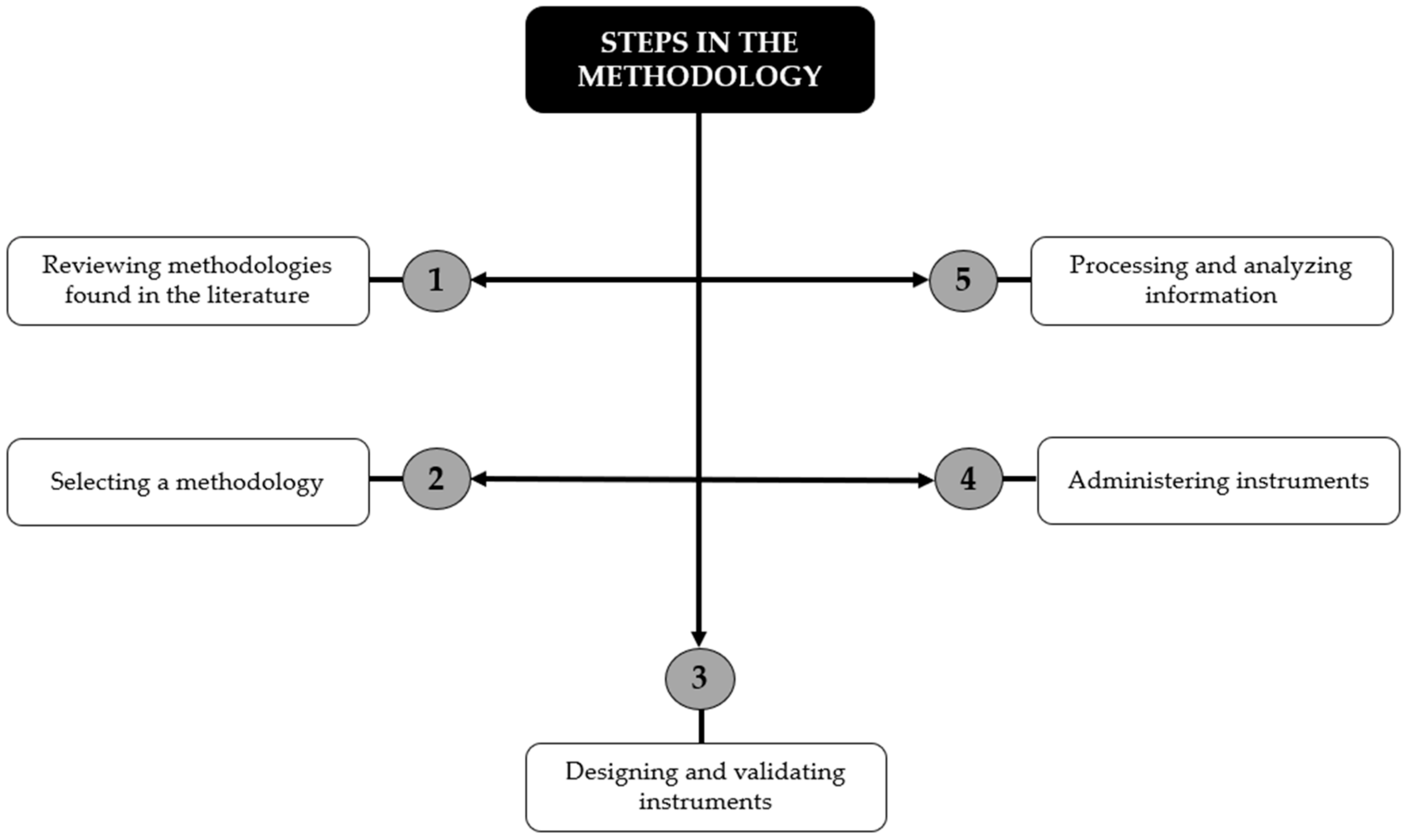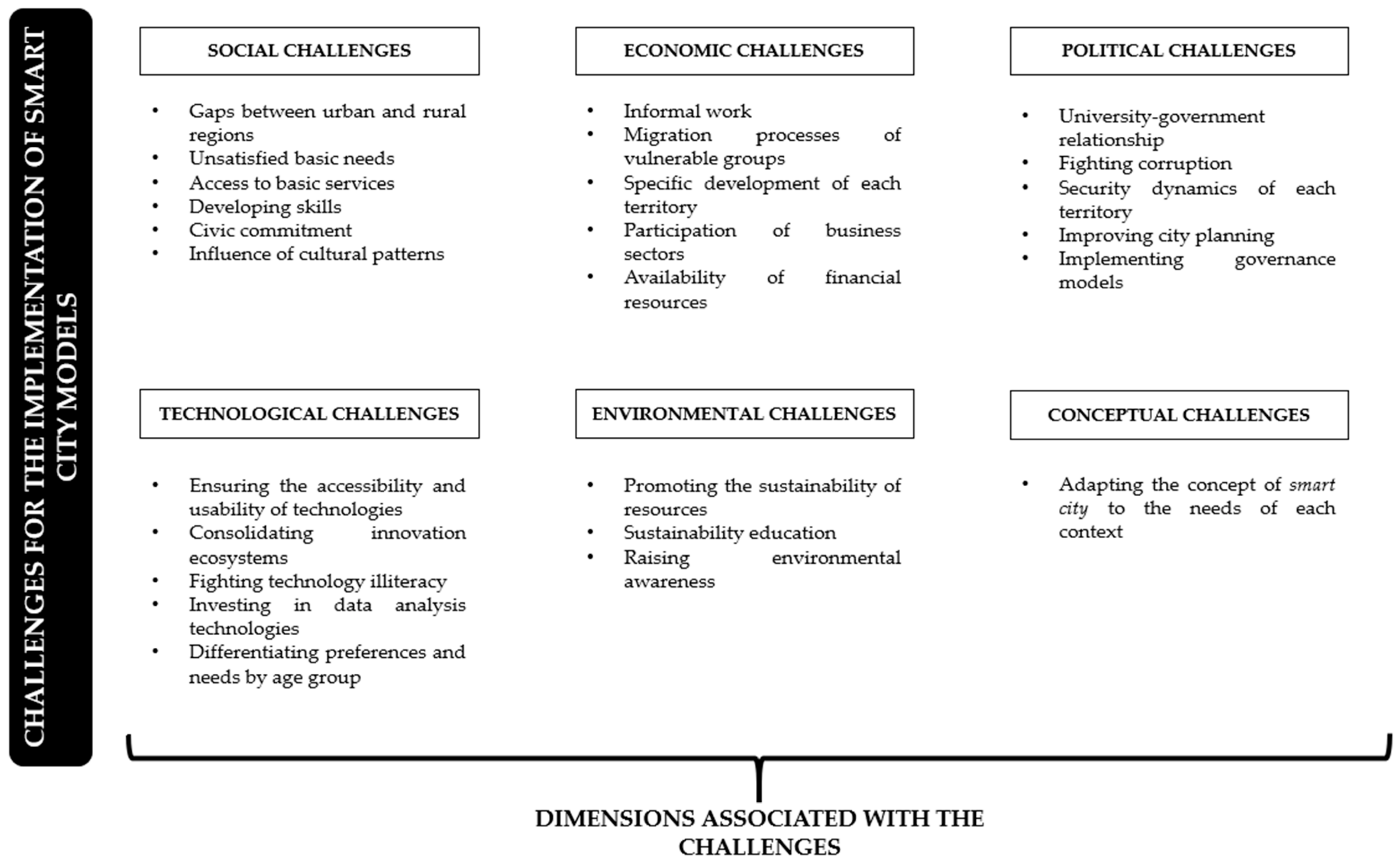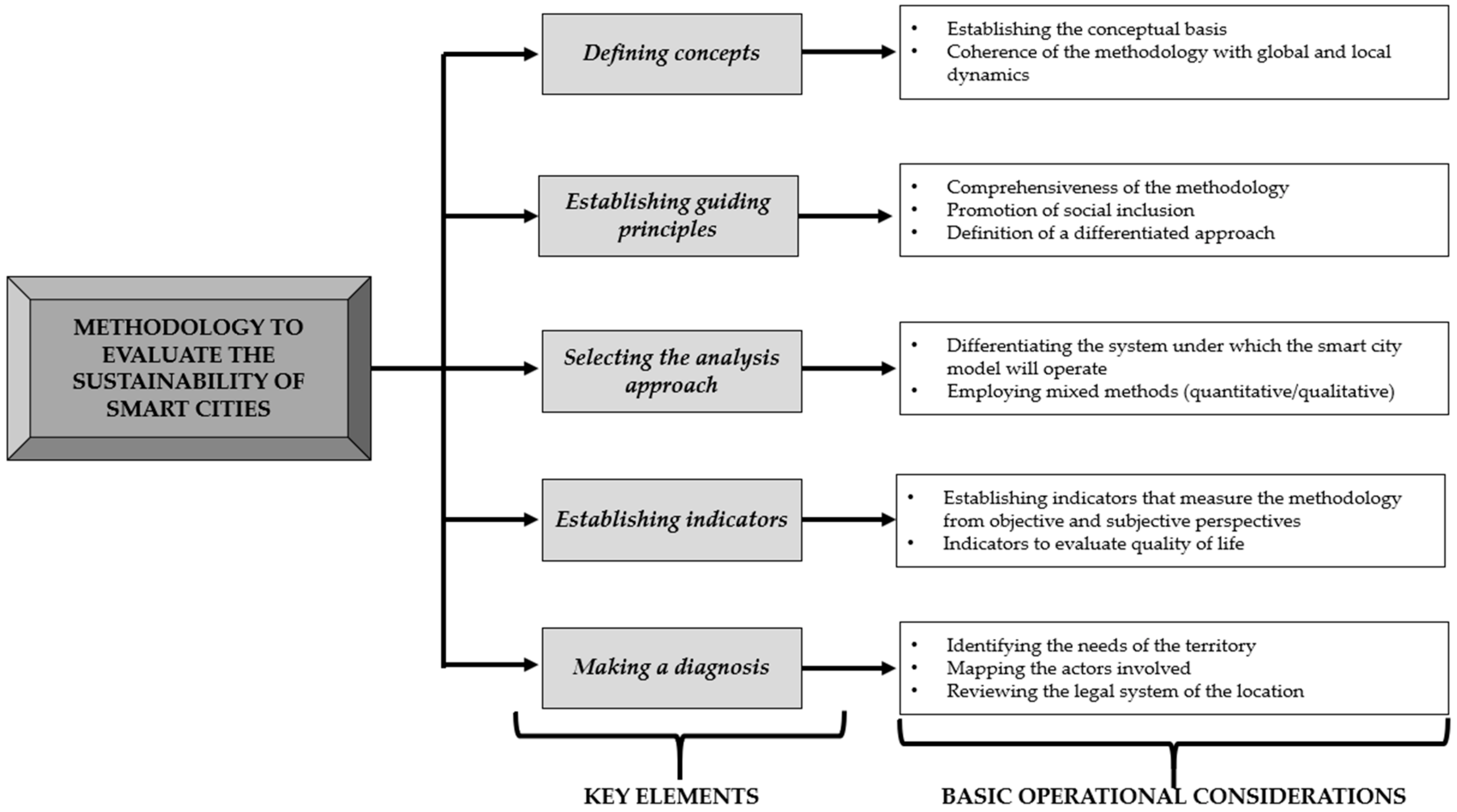A Methodological Model to Evaluate Smart City Sustainability
Abstract
:1. Introduction
2. Theoretical Background
2.1. Sustainable Development
2.2. Smart Cities
3. Materials and Methods
4. Results
4.1. Challenges for the Implementation of Smart City Models
“(…) there’s still a huge gap that kind of corresponds to the dynamics of this country. It’s that, well, the western part of town and El Poblado have undergone a kind of development that is very different from that of the communes up north or Buenos Aires. The form of development is very different in all those places.”.(E-01)
“(…) from a perspective that’s a little utopian, a smart city should be one where, at least, the basic needs of its citizens are met.”(E-01)
“(…) a city is dynamic, and the entire city does not behave in the same way. I think some places, neighborhoods, commercial places, and industrial areas should be classified by nodes with different needs.”(E-05)
“(…) some important things should be solved, for example, security, access to some services, such as health care.”(E-05)
“(…) smart cities may pose certain challenges related to consumption; labor and occupation; leisure; (very importantly) education; energy transportation with sustainability; and everything related to urban management, health, and well-being.”(E-08)
“I think developing human potential, an intangible asset, requires adequate spaces for social education and raising environmental awareness.”(E-07)
“(…) it should be not only a political intention with a deeper knowledge of smart cities but also that of citizens because smart cities need acceptable social behavior to be called that.”(E-04)
“(…) a pure, radical smart city model can’t be applied in some cases. That’s the first challenge: trying to deal with and differentiate those cultural characteristics so that any element of a smart city to be applied is feasible for the selected community.”(E-06)
“Something I think is a national problem rather than only in Medellín is the high rate of informal labor, which poses another challenge to consolidate a smart city.”(E-01)
“(…) It’s different here because it is not so feasible due to economic difficulties, the limited income of many individuals, and the irregular development of our cities, which occurs in waves of people who arrive in urban centers but whose minimum living conditions are not met. As a result, after a certain period, it’s back to square one, and that hinders a city from becoming smart.”(E-03)
“When a city is very dynamic and not all of it behaves in the same way, there are spots, neighborhoods, commercial places, and industrial areas that, I think, should be classified by nodes with differentiated needs.”.(E-05)
“(…) I think we have made some progress with strategies to promote innovation in the municipality or such as the Ruta N industrial complex, the articulation of the municipal government and universities.”(E-01)
“Ending the corruption existing at different levels of society, which hinders the latter from accomplishing its objectives.”(E-02)
“(…) if we’re talking about a smart city, it’s obviously a city that is significantly invested in the technological component. Obviously, it should guarantee not only the connectivity to networks but also their usability and that people appropriate them.”(E-01)
“The concept of smart city, to me, is an idealistic one because it includes a series of adaptations to use new technologies efficiently, but it is based on the idea that all the population has access to new information technologies.”(E-03)
“Sometimes you see people, even young individuals; for example, an average individual, a 40-year-old person may not like to use information and communication technologies to make transactions and report information. Not everyone does it. So, I think this question refers to one of the biggest challenges.”(E-07)
“The political part plays a leading role in the implementation and resource allocation of any project. For a smart city, it is vitally important that its political class understand the importance of sustainability and smart cities, as well as what it takes to become a smart city.”(E-04)
“(…) a smart sustainable city involves many aspects. A city can be smart but not sustainable if it focuses too much on exploiting current resources and ignores the fact that the world doesn’t end today, i.e., that it is necessary to offer possibilities and decent conditions to those who will come in 10, 15, 20, or 30 years. Therefore, a smart city should also be sustainable.”(E-03)
“Well, let’s say there are multiple challenges. The first one is defining what is understood by ‘city’ and ‘smart city’, identifying the characteristics of each city, its populational groups, and the communities that live there because a radical, pure smart city model can’t be applied in some cases. So, that’s the first challenge, trying to face and differentiate those cultural characteristics so that any element of smart city to be applied is indeed reasonable for the selected community.”(E-06)
4.2. Key Components in a Methodology to Evaluate Smart City Sustainability
“Well, the most important thing is the entire conceptual foundation. And I think that, to design a methodology such as the one proposed in this study, it has to be a methodology where the concepts are linked not only to global ideas. The 2030 Agenda is not the only reference point, but we should also define how to connect this to the local context.”(E-01)
“If we’re talking about sustainability, we must necessarily talk about comprehensiveness because sustainability has many components: political, social, economic, and environmental aspects. Therefore, the first and most important factor should be the comprehensiveness of the methodology.”(E-04)
“(…) the approach, for example, that you choose to design the methodology, whether quantitative or qualitative, should have indicators that can really provide an answer based on that ambivalence of an evaluation that is not only objective. Let’s say that statistics has very important properties as well, but let’s not forget people’s subjective appraisals.”(E-01)
“The degree of satisfaction of said needs should be measured employing some clearly defined metrics; certainly, there should be many reference models for that purpose. Now, any methodology implemented to evaluate the sustainability of a smart city should incorporate parameters and mechanisms that can be used to objectively evaluate the aspects mentioned earlier.”(E-03)
“(…) Another thing that’s important when we talk about methodologies is that let’s say, we are reusing them from other places in the world, which is very common in our scientific environment because in many of our studies what we do is to look at what others are doing in Europe and the United States in order to apply it to our territories. Then, an important factor is that the methodology can be adequately applied to our territory.”(E-04)
“The first factor in such methodology should be a good diagnosis to understand the needs of the city. Sometimes Medellín is compared to big cities. This is a small city, and, although it is the smartest and most innovative in Latin America, it has different needs.”(E-05)
“Regardless of the methodology, whether based on hard or soft systems thinking, you should consider the actors that can somehow have an influence on the phenomenon under analysis. With respect to smart city sustainability, who are the interested agents that may influence the sustainability process?”(E-06)
“(…) the methodological steps should resemble those you follow to design a custom-made dress; you should know the size and the measurements because it must fit perfectly. In this case, it should be adapted to a context such as ours, which is constantly changing. Regulations can constantly change; for example, the law we have today may be overturned in a month, and we have to draft a new one. I think that would be a factor.”(E-01)
5. Discussion
6. Conclusions
Author Contributions
Funding
Institutional Review Board Statement
Informed Consent Statement
Data Availability Statement
Conflicts of Interest
References
- Rana, N.P.; Luthra, S.; Mangla, S.K.; Islam, R.; Roderick, S.; Dwivedi, Y.K. Barriers to the Development of Smart Cities in Indian Context. Inf. Syst. Front. 2019, 21, 503–525. [Google Scholar] [CrossRef] [Green Version]
- Korczak, J.; Kijewska, K. Smart Logistics in the Development of Smart Cities. Transp. Res. Procedia 2019, 39, 201–211. [Google Scholar] [CrossRef]
- Yigitcanlar, T.; Kamruzzaman, M.; Buys, L.; Ioppolo, G.; Sabatini-Marques, J.; da Costa, E.M.; Yun, J.H.J. Understanding ‘Smart Cities’: Intertwining Development Drivers with Desired Outcomes in a Multidimensional Framework. Cities 2018, 81, 145–160. [Google Scholar] [CrossRef]
- Becerril-Elías, J.C.; Merritt, H. Alianzas para la innovación en organizaciones intensivas en conocimiento: El caso de México. Rev. CEA. 2021, 7, e1780. [Google Scholar] [CrossRef]
- Purvis, B.; Mao, Y.; Robinson, D. Three Pillars of Sustainability: In Search of Conceptual Origins. Sustain. Sci. 2019, 14, 681–695. [Google Scholar] [CrossRef] [Green Version]
- Schneider, F.; Kläy, A.; Zimmermann, A.B.; Buser, T.; Ingalls, M.; Messerli, P. How Can Science Support the 2030 Agenda for Sustainable Development? Four Tasks to Tackle the Normative Dimension of Sustainability. Sustain. Sci. 2019, 14, 1593–1604. [Google Scholar] [CrossRef] [Green Version]
- Miola, A.; Schiltz, F. Measuring Sustainable Development Goals Performance: How to Monitor Policy Action in the 2030 Agenda Implementation? Ecol. Econ. 2019, 164, 106373. [Google Scholar] [CrossRef]
- OECD. Measuring Distance to SDG Targets. An Assessment of Where OECD Countries Stand. June 2017. Available online: https://www.oecd.org/sdd/OECD-Measuring-Distance-to-SDG-Targets.pdf (accessed on 9 September 2021).
- Sachs, J.D.; Schmidt-Traub, G.; Mazzucato, M.; Messner, D.; Nakicenovic, N.; Rockström, J. Six Transformations to Achieve the Sustainable Development Goals. Nat. Sustain. 2019, 2, 805–814. [Google Scholar] [CrossRef]
- Klarin, T. The Concept of Sustainable Development: From its Beginning to the Contemporary Issues. Zagreb Int. Rev. Econ. Bus. 2018, 21, 67–94. [Google Scholar] [CrossRef] [Green Version]
- Mensah, J. Sustainable Development: Meaning, History, Principles, Pillars, and Implications for Human Action: Literature Review. Cogent Soc. Sci. 2019, 5, 1653531. [Google Scholar] [CrossRef]
- Roosa, S. Sustainable Development Handbook, 2nd ed.; Stephen, A., Ed.; River Publisher: New York, NY, USA, 2020. [Google Scholar]
- Vinuesa, R.; Azizpour, H.; Leite, I.; Balaam, M.; Dignum, V.; Domisch, S.; Felländer, A.; Langhans, S.D.; Tegmark, M.; Fuso Nerini, F. The Role of Artificial Intelligence in Achieving the Sustainable Development Goals. Nat. Commun. 2020, 11, 233. [Google Scholar] [CrossRef] [PubMed] [Green Version]
- Feil, A.A.; Schreiber, D. Sustentabilidade e Desenvolvimento Sustentável: Desvendando as Sobreposições e Alcances de Seus Significados. Cad. EBAPE.BR 2017, 15, 667–681. [Google Scholar] [CrossRef] [Green Version]
- Öberg, C.; Graham, G.; Hennelly, P. Smart Cities: A Literature Review and Business Network Approach Discussion on the Management of Organisations. IMP J. 2017, 11, 468–484. [Google Scholar] [CrossRef] [Green Version]
- Ismagilova, E.; Hughes, L.; Dwivedi, Y.K.; Raman, K.R. Smart Cities: Advances in Research—An Information Systems Perspective. Int. J. Inf. Manag. 2019, 47, 88–100. [Google Scholar] [CrossRef]
- Harrison, C.; Eckman, B.; Hamilton, R.; Hartswick, P.; Kalagnanam, J.; Paraszczak, J.; Williams, P. Foundations for Smarter Cities. IBM J. Res. Dev. 2010, 54, 1–16. [Google Scholar] [CrossRef]
- Caragliu, A.; del Bo, C.; Nijkamp, P. Smart Cities in Europe. J. Urban Technol. 2011, 18, 65–82. [Google Scholar] [CrossRef]
- Antrobus, D. Smart Green Cities: From Modernization to Resilience? Urban Res. Pract. 2011, 4, 207–214. [Google Scholar] [CrossRef]
- Chourabi, H.; Nam, T.; Walker, S.; Gil-Garcia, J.R.; Mellouli, S.; Nahon, K.; Pardo, T.A.; Scholl, H.J. Understanding Smart Cities: An Integrative Framework. In Proceedings of the Annual Hawaii International Conference on System Sciences IEEE Computer Society, Maui, HI, USA, 4–7 January 2012; pp. 2289–2297. [Google Scholar] [CrossRef]
- Bourkela, M.; Casseb, M.; Bassi, S.; De Lucca, C.; Facchina, M. (Eds.) The Road Toward Smart Cities. Inter—American Development Bank (IDB). 2016. Available online: https://publications.iadb.org/publications/english/document/The-Road-toward-Smart-Cities-Migrating-from-Traditional-City-Management-to-the-Smart-City.pdf (accessed on 9 September 2021).
- Trindade, E.P.; Hinnig, M.P.F.; da Costa, E.M.; Marques, J.S.; Bastos, R.C.; Yigitcanlar, T. Sustainable Development of Smart Cities: A Systematic Review of the Literature. J. Open Innov. Technol. Mark. Complex. 2017, 3, 11. [Google Scholar] [CrossRef] [Green Version]
- Patton, M.Q. Qualitative Research. In Encyclopedia of Statistics in Behavioral Science; John Wiley & Sons, Ltd.: Chichester, UK, 2005. [Google Scholar] [CrossRef]
- Izquierdo, G.M. Informantes y Muestreo En Investigación Cualitativa. Inf. Y Muestreo En Investig. Cual. 2015, 17, 1148–1150. [Google Scholar] [CrossRef]
- Martínez, I.P.; Alvarez, R.M. Importance of Research Ethics Committees in Family Medicine. Aten. Prima. 2019, 51, 263–265. [Google Scholar] [CrossRef]
- Salgado, A.C. Investigación Cualitativa: Diseños, Evaluación Del Rigor Metodológico y Retos. Liberabit 2007, 13, 71–78. [Google Scholar]
- Nerini, F.F.; Slob, A.; Engström, R.E.; Trutnevyte, E. A Research and Innovation Agenda for Zero-Emission European Cities. Sustainability 2019, 11, 1692. [Google Scholar] [CrossRef] [Green Version]
- Wendling, L.A.; Huovila, A.; zu Castell-Rüdenhausen, M.; Hukkalainen, M.; Airaksinen, M. Benchmarking Nature-Based Solution and Smart City Assessment Schemes against the Sustainable Development Goal Indicator Framework. Front. Environ. Sci. 2018, 6, 69. [Google Scholar] [CrossRef] [Green Version]
- Pratt, A.C. Creative Cities: The Cultural Industries and the Creative Class. Geogr. Ann. Ser. B Hum. Geogr. 2016, 90, 107–117. [Google Scholar] [CrossRef] [Green Version]
- Scott, A.J. Resurgent Metropolis: Economy, Society and Urbanization in an Interconnected World. Int. J. Urban Reg. Res. 2008, 32, 548–564. [Google Scholar] [CrossRef]
- De Guimarães, J.C.F.; Severo, E.A.; Felix Júnior, L.A.; Da Costa, W.P.L.B.; Salmoria, F.T. Governance and Quality of Life in Smart Cities: Towards Sustainable Development Goals. J. Clean. Prod. 2020, 253, 119926. [Google Scholar] [CrossRef]
- Fischer, L.-B.; Newig, J. Importance of Actors and Agency in Sustainability Transitions: A Systematic Exploration of the Literature. Sustainability 2016, 8, 476. [Google Scholar] [CrossRef] [Green Version]
- Bai, X.; Nath, I.; Capon, A.; Hasan, N.; Jaron, D. Health and Wellbeing in the Changing Urban Environment: Complex Challenges, Scientific Responses, and the Way Forward. Curr. Opin. Environ. Sustain. 2012, 4, 465–472. [Google Scholar] [CrossRef] [Green Version]
- Kaur, H.; Garg, P. Urban Sustainability Assessment Tools: A Review. J. Clean. Prod. 2019, 210, 146–158. [Google Scholar] [CrossRef]
- Bonham-Carter, C. Sustainable Communities, 1st ed.; Clark, W.W., Ed.; Springer: New York, NY, USA, 2009. [Google Scholar] [CrossRef]
- Sev, A. A Comparative Analysis of Building Environmental Assessment Tools and Suggestions for Regional Adaptations. Civ. Eng. Environ. Syst. 2011, 28, 231–245. [Google Scholar] [CrossRef]
- CASBEE. CASBEE for Urban Development (2014 Edition). Comprehensive Assessment System for Building Environmental Efficiency. Technical Manual 2014 Edition. 2014. Available online: https://www.ibec.or.jp/CASBEE/english/ (accessed on 9 September 2021).
- Indian Green Building Council. IGBC Green Townships Rating System—Abridged Reference Guide Pilot Version Ed; Indian Green Building Council: Telangana, India, 2010. [Google Scholar]
- Yan, Y.; Wang, C.; Quan, Y.; Wu, G.; Zhao, J. Urban Sustainable Development Efficiency towards the Balance between Nature and Human Well-Being: Connotation, Measurement, and Assessment. J. Clean. Prod. 2018, 178, 67–75. [Google Scholar] [CrossRef]
- Nam, T.; Pardo, T.A. Smart City as Urban Innovation: Focusing on Management, Policy, and Context. In Proceedings of the 5th International Conference on Theory and Practice of Electronic Governance, Tallinn, Estonia, 26–28 September 2011; pp. 185–194. [Google Scholar] [CrossRef]
- Belissent, J.; Giron, F. Service Providers Accelerate Smart City Projects; Forrester Research Report; Forrester Publication United Kingdom: London, UK, July 2013; Available online: https://silo.tips/download/service-providers-accelerate-smart-city-projects (accessed on 9 September 2021).
- Albino, V.; Berardi, U.; Dangelico, R.M. Smart Cities: Definitions, Dimensions, Performance, and Initiatives. J. Urban Technol. 2015, 22, 3–21. [Google Scholar] [CrossRef]
- Lupiañez Villanueva, F. Ciudades Inteligentes: Evaluación Social de Proyectos de Smart Cities; Centro de Estudios de Telecomunicaciones de América Latina: Montevideo, Uruguay, August 2017; Available online: https://cet.la/estudios/cet-la/ciudades-inteligentes-evaluacion-social-proyectos-smart-cities/ (accessed on 9 September 2021).
- Anthopoulos, L.; Fitsilis, P. From Digital to Ubiquitous Cities: Defining a Common Architecture for Urban Development. In Proceedings of the 2010 6th International Conference on Intelligent Environments (IE 2010), Kuala Lumpur, Malaysia, 19–21 July 2010; pp. 301–306. [Google Scholar] [CrossRef]
- Alderete, M.V. ¿Qué Factores Influyen En La Construcción de Ciudades Inteligentes? Un Modelo Multinivel Con Datos a Nivel Ciudades y Países. Rev. Iberoam. Cienc. Tecnol. Soc.—CTS 2019, 14, 71–89. [Google Scholar]



| Author | Year of Publication | Definition of Smart City |
|---|---|---|
| Harrison et al. [17] | 2010 | Smart cities connect the physical infrastructure, the IT infrastructure, the social infrastructure, and the business infrastructure to leverage the collective intelligence of the city [17]. |
| Caragluiu et al. [18] | 2011 | A city is smart when it invests in human and social capital and traditional (transportation) and modern (ICTs) communication infrastructures to boost sustainable economic growth and generate a high quality of life, with a rational management of natural resources through participatory governance. |
| Antrobus, Derek [19] | 2011 | The emphasis of smart cities is on the low-carbon economy. For that purpose, they apply policies focused on eco-friendly modernization, which may reduce the greenhouse gas effect and help to identify potential combined energy sources that involve local development. |
| Chourabi et al. [20] | 2012 | The smart city tag is a diffuse concept that is not always used consistently; it may refer to a high-performing progressive city. |
| Bouskela et al. [21] | 2016 | Smart cities put people at the center of development, incorporating ICTs into urban management, and use these elements as tools to stimulate the formation of an efficient government that includes collaborative and citizen planning processes. |
Publisher’s Note: MDPI stays neutral with regard to jurisdictional claims in published maps and institutional affiliations. |
© 2021 by the authors. Licensee MDPI, Basel, Switzerland. This article is an open access article distributed under the terms and conditions of the Creative Commons Attribution (CC BY) license (https://creativecommons.org/licenses/by/4.0/).
Share and Cite
Valencia-Arias, A.; Urrego-Marín, M.L.; Bran-Piedrahita, L. A Methodological Model to Evaluate Smart City Sustainability. Sustainability 2021, 13, 11214. https://doi.org/10.3390/su132011214
Valencia-Arias A, Urrego-Marín ML, Bran-Piedrahita L. A Methodological Model to Evaluate Smart City Sustainability. Sustainability. 2021; 13(20):11214. https://doi.org/10.3390/su132011214
Chicago/Turabian StyleValencia-Arias, Alejandro, María Lucelly Urrego-Marín, and Lemy Bran-Piedrahita. 2021. "A Methodological Model to Evaluate Smart City Sustainability" Sustainability 13, no. 20: 11214. https://doi.org/10.3390/su132011214
APA StyleValencia-Arias, A., Urrego-Marín, M. L., & Bran-Piedrahita, L. (2021). A Methodological Model to Evaluate Smart City Sustainability. Sustainability, 13(20), 11214. https://doi.org/10.3390/su132011214







